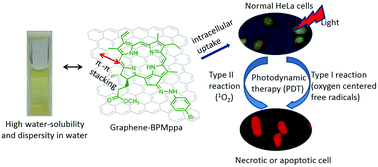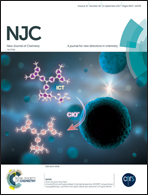Facile synthesis of a highly water-soluble graphene conjugated chlorophyll-a photosensitizer composite for improved photodynamic therapy in vitro†
Abstract
In photodynamic therapy (PDT), selection of an ideal photosensitizer and improvement of its photodynamic activities are currently of great interest. In this work, a chlorophyll-a photosensitizer derivative, p-bromo-phenylhydrazone-methyl pyropheophorbide-a (BPMppa) with a long absorption wavelength (683 nm) and a large molar extinction coefficient (7.03 × 104 M−1 cm−1), which is considered to be more suitable for the treatment of deep cancer, is loaded onto pristine graphene using a direct graphite exfoliation process via π–π stacking in water. The obtained graphene loaded photosensitizer G–BPMppa composite shows significantly improved water-solubility and dispersity in water, PBS and culture medium, and an increased singlet oxygen (1O2) quantum yield (ΦΔ = 60.55%) in DMF solution compared to free BPMppa (ΦΔ = 29.2%). In addition, cell experiments indicated that the G–BPMppa composite could be taken up by HeLa cells successfully, showing enhanced intracellular uptake behavior. Owing to its enhanced intracellular uptake and higher 1O2 quantum yield, G–BPMppa showed remarkably improved PDT efficiency (IC50: 1.36 ± 0.35 μg mL−1 of equivalent BPMppa) over free BPMppa after irradiation, but low dark toxicity without irradiation. Moreover, cell morphological changes after G–BPMppa PDT further qualitatively demonstrated that G–BPMppa could induce damage and apoptotic cell death efficiently. Furthermore, the photochemical mechanism of the G–BPMppa mediated PDT process was investigated by using specific quenching agents, sodium azide (SA, a singlet oxygen quencher) and D-mannitol (DM, a hydroxyl radical quencher); the results indicated that type I and type II photodynamic reactions could occur simultaneously, yet the type II reaction (the generation of 1O2) might play a predominant role in the G–BPMppa induced PDT process.



 Please wait while we load your content...
Please wait while we load your content...